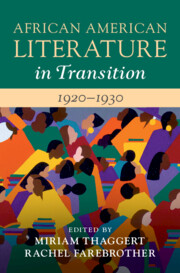Book contents
- African American Literature in Transition, 1920–1930
- African American Literature in Transition
- African American Literature in Transition, 1920–1930
- Copyright page
- Contents
- Illustrations
- Contributors
- Acknowledgments
- Chronology of Historical Events, People, and Publications, 1920–1930
- Preface
- Introduction
- Part I Habitus, Sound, Fashion
- Part II Space
- Part III Uplift Renewed
- Chapter 8 “The sinful babel of the airshaft”
- Chapter 9 Marcus Garvey
- Chapter 10 Progression or Regression of the Black Race?
- Part IV Serial Reading
- Bibliography
- Index
Chapter 9 - Marcus Garvey
Popular Culture and Black Liberation
from Part III - Uplift Renewed
Published online by Cambridge University Press: 17 March 2022
- African American Literature in Transition, 1920–1930
- African American Literature in Transition
- African American Literature in Transition, 1920–1930
- Copyright page
- Contents
- Illustrations
- Contributors
- Acknowledgments
- Chronology of Historical Events, People, and Publications, 1920–1930
- Preface
- Introduction
- Part I Habitus, Sound, Fashion
- Part II Space
- Part III Uplift Renewed
- Chapter 8 “The sinful babel of the airshaft”
- Chapter 9 Marcus Garvey
- Chapter 10 Progression or Regression of the Black Race?
- Part IV Serial Reading
- Bibliography
- Index
Summary
Reading Marcus Garvey as a brilliant popular culture practitioner, this chapter situates Garvey vis-à-vis his Black contemporaries to challenge readings of Garveyism and the UNIA that have tended to repeat limiting narratives of rise and fall, tragedy and farce, and failure. Paying careful attention to the use of uniforms, pamphlets, parades, songs, speeches, and pageantry within Garveyism, Russell analyzes Garvey as a popular cultural artist before such a concept was even conceived. The chapter is particularly sensitive to the affective dimensions of performance within Garveyism. UNIA members across the African diaspora participated in performance as embodied futurity by marching, singing the anthem, and wearing UNIA uniforms, enacting a utopian vision of Black liberation and unity that facilitated the construction of what Benedict Anderson has called an “imagined community”.
- Type
- Chapter
- Information
- African American Literature in Transition, 1920–1930 , pp. 232 - 257Publisher: Cambridge University PressPrint publication year: 2022

